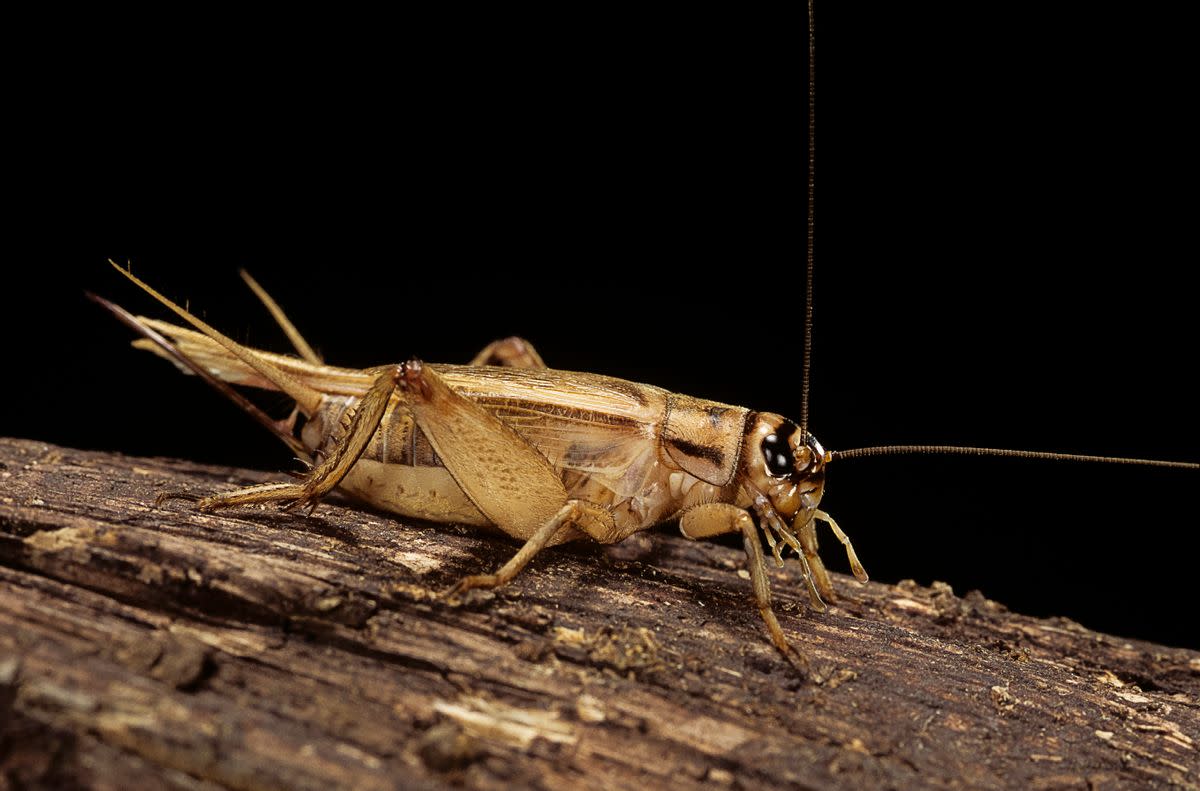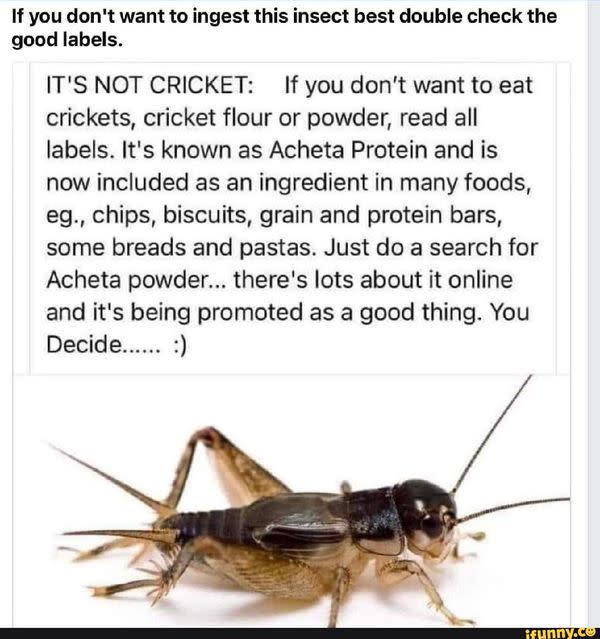Fact Check: Ground Crickets Are Supposedly Added to Foods Under the Name 'Acheta Powder.' Here's What We Found

Claim:
Cricket powder is commonly added to many foods under the name "Acheta powder" or "Acheta protein" and is "being promoted as a good thing."
Rating:
Context:
Cricket powder or cricket flour, made of ground up crickets, is commonly sold under the name Acheta powder or Acheta protein and some brands do make food with Acheta powder in it. Snopes is actively investigating exactly how common that practice is.
Although insects are not generally considered a staple of American diets, eating them is quite common worldwide.
In recent years, social media posts have attempted to raise the alarm on Americans supposedly eating them — crickets, in particular — without knowing it. Among such posts is an image of a cricket with the caption:
IT'S NOT CRICKET: If you don't want to eat crickets, cricket flour or powder, read all labels. It's known as Acheta protein and is now included as an ingredient in many foods, eg., chips, biscuits, grain and protein bars, some breads and pastas. Just do a search for Acheta powder... there's lots online about it and it's being promoted as a good thing. You decide...... :)

(iFunny user @NotAGlobe)
This post makes three claims: 1.) Cricket powder, or cricket flour, is sold and marketed as "Acheta protein"; 2.) Cricket powder is commonly used in "many foods," generally breads and other carbohydrates; 3.) Cricket powder is being promoted as a good thing.
First off, yes, cricket powder, sometimes called cricket flour, does exist and can be found in some foods like "chips, biscuits, grain and protein bars, some breads and pastas," as the viral image alleges. It is also sometimes named Acheta powder, or Acheta protein, since the genus of the house cricket is Acheta domesticus.
The viral post did not name specific brands of food supposedly containing the powder. Snopes found several examples of companies that make products containing crickets or cricket powder, including Chirps and EXO protein. These companies openly advertise that their products are made of crickets or Acheta protein — although EXO exclusively describes its protein bars as containing "Acheta protein" without explaining its origin.
Snopes has reached out to several larger U.S. manufacturers of snack foods and breads to ask if they included the ingredient in products. We will update the story if we hear back from them.
As the text in the image suggests, edible crickets in different forms have grown in popularity in recent years. Several factors explain the trend, all of which are backed by peer-reviewed scientific studies, though research into the area is still relatively new.
Among the positives often cited, crickets are high in protein, fiber, healthy fats and other nutrients. Cricket powder has also been found to be a good source of protein. Crickets are environmentally friendly because farming crickets doesn't require a lot of food or fancy equipment. Even more, crickets have a type of fiber in their exoskeleton called chitin that has anti-inflammatory properties and can improve gut health.
In the U.S., there is no explicit law governing the production of edible insects, but the Food and Drug Administration (FDA) has issued guidelines on safety and health standards.
Per our understanding of those guidelines, whole crickets used for food must be raised for that purpose. In other words, in the U.S., edible insects like crickets must explicitly be raised to be eaten, just like a cow or a chicken would be. But the FDA does not necessarily regulate cricket powder (i.e., Acheta powder) in the same way as whole crickets. According to the FDA, cricket powder is considered a protein powder — added to foods to increase protein content — and thus can be classified as a dietary supplement, which have slightly looser requirements.
Snopes contacted the FDA for additional clarification about these requirements and received the following information from an FDA spokesperson:
Under the Federal Food, Drug, and Cosmetic Act (FD&C Act), food must be safe and may not bear any added poisonous or added deleterious substance that is unsafe. Food may not be prepared, packed, or held under insanitary conditions, and must be produced in accordance with Current Good Manufacturing Practice (CGMP) regulations for manufacturing/processing, packing, or holding human food. Therefore, insects that are used as food or food ingredient must comply with the FD&C Act.
The FD&C Act also includes requirements that pertain to the labeling of food and preventive controls, as applicable. The ingredients in food must be declared in the ingredient statement on the label of the food by their common or usual names. Manufacturers have a responsibility to ensure that the food they produce for the United States market is safe and complies with the FD&C Act and the FDA's implementing regulations.
As far as the powder found in foods, there's a key reason why some companies aren't using it: allergies.
The exoskeletons in crickets are similar to those found in shellfish, including shrimp, crabs and lobsters. In fact, people with shellfish allergies are more likely to be allergic to crickets and other edible insects like cicadas. This fact makes adding crickets into various foods without advertising it as such quite risky. Mistakes in labeling could lead to a lawsuit.
But apart from the possibility of an allergic reaction, eating crickets doesn't appear to be harmful. However, if you are truly concerned about whether your snack foods have been supplemented with cricket protein, we recommend following the advice shared on social media: Look at the ingredients.
Sources:
Bob. "FDA Guidance on Edible Insects as Foods." The Future Of Edible Insects, 5 Mar. 2016, https://thefutureofedibleinsects.com/2016/03/05/fda-guidance-on-edible-isects-as-foods/.
Can Crickets Be Used in Baked Goods? | Blog | BAKERpedia. 9 Jan. 2016, https://bakerpedia.com/can-crickets-used-baked-goods/.
DeFacendis, Michelle. "Mythbuster: If Someone Has a Crustacean Allergy, Should They Avoid Edible Insects like Crickets?" Food Allergy Canada, 21 Apr. 2022, https://foodallergycanada.ca/mythbuster-if-someone-has-a-crustacean-allergy-should-they-avoid-edible-insects-like-crickets/.
"Eating Crickets: Benefits and Downsides." Healthline, 6 May 2021, https://www.healthline.com/nutrition/eating-crickets.
Entomophagy | Sustainable, Nutritious Insect-Based Diet | Britannica. https://www.britannica.com/topic/entomophagy. Accessed 26 Apr. 2024.
Facebook. https://www.facebook.com/oildalesqueen/posts/pfbid0w8GFzxx1hdzjgh63AhV9RVJknNSewmLGPyJCBjkb6CrmGtTvZeHf2Y6Kmt5SwMA4l. Accessed 26 Apr. 2024.
"Food Allergies: The 'Big 9.'" Food Safety and Inspection Service, U.S. Department of Agriculture, https://www.fsis.usda.gov/food-safety/safe-food-handling-and-preparation/food-safety-basics/food-allergies#:~:text=For%20those%20who%20are%20sensitive,wheat%2C%20soybeans%2C%20and%20sesame.
"Https://Twitter.Com/KimPigSquash/Status/1725337565283422552." X (Formerly Twitter), https://twitter.com/KimPigSquash/status/1725337565283422552. Accessed 26 Apr. 2024.
Larouche, Jennifer, et al. "The Edible Insect Sector in Canada and the United States." Animal Frontiers: The Review Magazine of Animal Agriculture, vol. 13, no. 4, Aug. 2023, pp. 16–25. PubMed Central, https://doi.org/10.1093/af/vfad047.
LaVolpe, Natalie. "What the Heck Is Cricket Flour?" Farmers' Almanac - Plan Your Day. Grow Your Life., 5 June 2017, https://www.farmersalmanac.com/what-is-cricket-flour.
NotAGlobe. "If You Don't Want to Ingest This Insect Best Double Check the Good Labels. IT'S NOT CRICKET: If You Don't Want to Eat Crickets, Cricket Flour or Powder, Read All Labels. It's Known as Acheta Protein and Is Now Included as an Ingredient in Many Foods, Eg., Chips, Biscuits, Grain and Protein Bars, Some Breads and Pastas. Just Do a Search for Acheta Powder... There's Lots about It Online and It's Being Promoted as a Good Thing. You Decide......" iFunny, https://ifunny.co/picture/if-you-don-t-want-to-ingest-this-insect-best-1ZPJa8FHA. Accessed 26 Apr. 2024.
Nutrition, Center for Food Safety and Applied. "Generally Recognized as Safe (GRAS)." FDA, 16 Oct. 2023, https://www.fda.gov/food/food-ingredients-packaging/generally-recognized-safe-gras.
---. "Types of Food Ingredients." FDA, Feb. 2024. www.fda.gov, https://www.fda.gov/food/food-additives-and-gras-ingredients-information-consumers/types-food-ingredients.
---. "Understanding How the FDA Regulates Food Additives and GRAS Ingredients." FDA, Feb. 2024. www.fda.gov, https://www.fda.gov/food/food-additives-and-gras-ingredients-information-consumers/understanding-how-fda-regulates-food-additives-and-gras-ingredients.
TikTok - Make Your Day. https://www.tiktok.com/@tanjaa911/video/7145234632433290501?q=acheta%20powder%20cricket&t=1714155965833. Accessed 26 Apr. 2024.
"What Is Acheta Protein? Why You Might Want To Give Cricket Powder a Try." Cleveland Clinic, https://health.clevelandclinic.org/acheta-protein-eating-crickets. Accessed 26 Apr. 2024.
Zafar, Aimen, et al. "Unraveling the Nutritional, Biofunctional, and Sustainable Food Application of Edible Crickets: A Comprehensive Review." Trends in Food Science & Technology, vol. 143, Jan. 2024, p. 104254. ScienceDirect, https://doi.org/10.1016/j.tifs.2023.104254.


